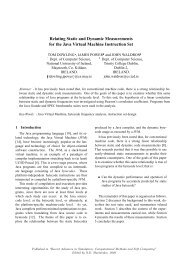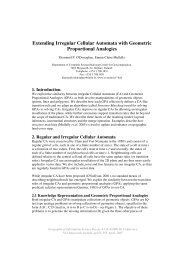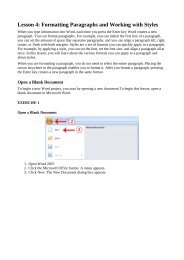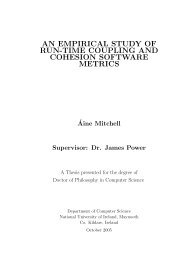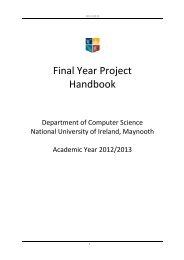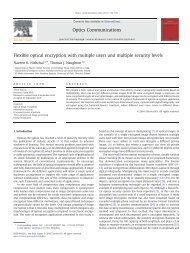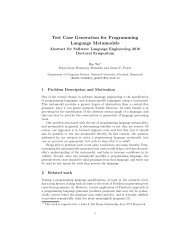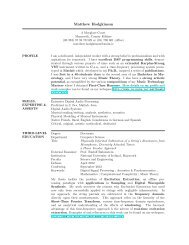Intra-Class Testing of Abstract Class Features - Computer Science
Intra-Class Testing of Abstract Class Features - Computer Science
Intra-Class Testing of Abstract Class Features - Computer Science
Create successful ePaper yourself
Turn your PDF publications into a flip-book with our unique Google optimized e-Paper software.
<strong>Intra</strong>-<strong>Class</strong> <strong>Testing</strong> <strong>of</strong> <strong>Abstract</strong> <strong>Class</strong> <strong>Features</strong>Peter J. Clarke, Djuradj Babich, Tariq M. KingSchool <strong>of</strong> Computing and Information <strong>Science</strong>sFlorida International UniversityMiami, FL 33199, USA{clarkep, dbabi001, tking003}@cis.fiu.eduJames F. PowerDepartment <strong>of</strong> <strong>Computer</strong> <strong>Science</strong>National University <strong>of</strong> Ireland, MaynoothCo. Kildare, Irelandjpower@cs.nuim.ie<strong>Abstract</strong>One <strong>of</strong> the characteristics <strong>of</strong> the increasingly widespreaduse <strong>of</strong> object-oriented libraries and the resulting intensiveuse <strong>of</strong> inheritance is the proliferation <strong>of</strong> dependencies onabstract classes. Such classes defer the implementation <strong>of</strong>some features, and are typically used as a specification ordesign tool. However, since their features are not fully implemented,abstract classes cannot be instantiated, and thuspose challenges for execution-based testing strategies.This paper presents a structured approach that supportsthe testing <strong>of</strong> features in abstract classes. Core to the approachis a series <strong>of</strong> static analysis steps that build a comprehensiveview <strong>of</strong> the inter-class dependencies in the systemunder test. We then leveraged this information to definea test order for the methods in an abstract class thatminimizes the number <strong>of</strong> stubs required during testing, andclearly identifies the required functionality <strong>of</strong> these stubs.Our approach is based on a comprehensive taxonomy <strong>of</strong>object-oriented classes that provides a framework for ouranalysis. First we describe the algorithms to calculate theinter-class dependencies and the test-order that minimizesstub creation. Then we give an overview <strong>of</strong> our tool, <strong>Abstract</strong>TestJthat implements our approach by generating atest order for the methods in an abstract Java class. Finally,we harness this tool to provide an analysis <strong>of</strong> 12 substantialJava applications that demonstrates both the feasibility <strong>of</strong>our approach and the importance <strong>of</strong> this technique.1. IntroductionThe widespread use <strong>of</strong> object-oriented (OO) libraries,and more recently plug-ins for integrated development environments(IDEs), has led to an emphasis being placedon validating the correct behavior <strong>of</strong> these components.These components extensively use the properties <strong>of</strong> the OOparadigm, i.e., abstract data types, inheritance and dynamicbinding <strong>of</strong> method calls. One <strong>of</strong> the properties <strong>of</strong> inheritancethat increases its flexibility is the ability to defer theimplementation <strong>of</strong> members in one class, an abstract class,to one or more <strong>of</strong> its concrete derived classes. Many <strong>of</strong> thepreviously mentioned components implement design patternsthat use abstract classes as a key part <strong>of</strong> their implementation.A plethora <strong>of</strong> testing techniques have been developedduring the last two decades to test OO s<strong>of</strong>tware. These OOtesting techniques cover all the phases <strong>of</strong> the developmentcycle, from unit testing through system testing. Most <strong>of</strong> thetesting techniques focus on aspects <strong>of</strong> the specification, implementation,or a combination <strong>of</strong> both. One area <strong>of</strong> testingOO s<strong>of</strong>tware that has not received much attention is testing<strong>of</strong> abstract classes. This lack <strong>of</strong> concentration partiallystems from the inability to instantiate objects <strong>of</strong> abstractclasses, thereby preventing them from being able to be executedat runtime. However, there are benefits to be gainedfrom testing the functionality <strong>of</strong> abstract classes. One suchbenefit is the reuse <strong>of</strong> test cases from the test history <strong>of</strong> theabstract class to validate any <strong>of</strong> its concrete derived classes[15]. In addition, testing the features <strong>of</strong> an abstract classto be used in libraries provides a level <strong>of</strong> confidence to thedeveloper with respect to the correctness <strong>of</strong> the functionalityderived from the abstract class. This testing activity canlead to the provision <strong>of</strong> higher quality libraries to be usedby other s<strong>of</strong>tware developers.In this paper we present an approach to support the intraclasstesting <strong>of</strong> the features in an abstract class. Our approachfirst classifies the characteristics <strong>of</strong> the classes inan OO application, then for each abstract class, identifiesthe methods <strong>of</strong> the abstract class that can be tested in itsconcrete descendants. The approach involves: performinglightweight dependency analysis <strong>of</strong> the inherited methods<strong>of</strong> the concrete descendants; generating an integration testorder for the methods in the abstract class; and using thetest order to minimize the number <strong>of</strong> stubs required whentesting the inherited methods in the concrete descendants.To validate our approach and show its practicality, we havedeveloped a testing tool <strong>Abstract</strong>TestJ and performed ex-
periments on a cross-section <strong>of</strong> OO applications. These applicationsrange in size from a few hundred classes to over21K classes.The contributions <strong>of</strong> this paper are as follows:1. The development <strong>of</strong> an approach to support the intraclasstesting <strong>of</strong> methods in an abstract class through itsconcrete descendants by:(a) identifying truly inherited methods using dependencyanalysis, i.e., those methods with dependencieslimited to the abstract class;(b) generating a test order that minimizes the number<strong>of</strong> stubs required when testing methods <strong>of</strong> anabstract class; and(c) minimizing the number <strong>of</strong> methods that need tobe tested in a newly created concrete descendantclass.2. The development <strong>of</strong> a tool that fully implements andautomates this approach.This paper is organized as follows. Section 2 presentsbackground information and Section 3 the motivation forthe work. The overview <strong>of</strong> the testing approach is presentedin Section 4. The detailed testing approach and tool supportare described in Sections 5 and 6 respectively. Section 7contains the experimental results. Section 8 presents therelated work and we conclude in Section 9.2. BackgroundThis section provides background information on the notion<strong>of</strong> inheritance hierarchies and abstract classes, the currentapproaches to test the features <strong>of</strong> abstract classes, andhow stubs are used during testing. We also introduce terminologythat threads the paper.2.1. Inheritance and <strong>Abstract</strong> <strong>Class</strong>esInheritance is one <strong>of</strong> the major concepts <strong>of</strong> the OOparadigm and can be used to provide extensibility andreusability <strong>of</strong> classes. Meyer [22] informally defines inheritanceas a mechanism whereby a class is defined in referencesto others, adding all their features (fields and methods)to its own. This definition is captured formally asR = P ⊕ ∆R, where R denotes the newly defined class(or child), P the properties inherited from another class (orparent), and ∆R the new properties that differentiate R andP [26]. The operator ⊕ represents a method <strong>of</strong> combiningthe inherited and new properties.The inheritance hierarchy may be viewed as a tree (singleinheritance) due to the transitivity <strong>of</strong> the ⊕ operator, oras a directed acyclic graph (multiple inheritance) due to applying⊕ operator to more than one parent. We use the termancestor <strong>of</strong> a class C to refer to the immediate and nonimmediateparents <strong>of</strong> a class. Similarly, the terms descendantrefers to the immediate and non-immediate children<strong>of</strong> a class [26]. In this paper we focus on the semantics <strong>of</strong>inheritance as provided by the Java language [14].An abstract class is a class that contains a deferred feature[22]. That is, at least one <strong>of</strong> the features in the interface<strong>of</strong> the class is not implemented. No instances <strong>of</strong>an abstract class can be created. A class inherited froman abstract class that is not abstract will be referred to aseither a concrete child or a concrete descendant since wedo not consider non-immediate descendants in this paper.<strong>Class</strong> features inherited unchanged are referred to as inheritedfeatures (recursive in [15]) and the overridden methodsas redefined methods [15]. If an inherited method only hasdependencies in the parent class where it is defined we referto that method as a truly inherited method.2.2. <strong>Testing</strong> <strong>Abstract</strong> <strong>Class</strong>esSeveral approaches are described in the literature [5,21, 28] that can be used to test the features <strong>of</strong> an abstractclass. These are: (1) defining a concrete class solely forthe purpose <strong>of</strong> testing the abstract class, (2) testing the abstractclass as part <strong>of</strong> testing the first concrete descendant,(3) testing the minimal set <strong>of</strong> concrete descendants that donot redefine the methods in the abstract parent class, and(4) using guided inspection. The first three approachesare execution-based, similar to the approach we present inthis paper. The test cases to validate the features in theconcrete descendants can be generated using specificationbased,implementation-based, or hybrid-based testing techniques[5, 15].When testing the features <strong>of</strong> a concrete class there maybe overhead incurred due to the creation <strong>of</strong> stubs. For example,a stub may be required if there is a cyclic dependencybetween two methods in a class or the there is a dependencyto another method that is not available at the time <strong>of</strong> testing.Finding an integration test order for the features in a class issimilar to finding a test order for a cluster <strong>of</strong> classes. That is,the test order is produced by generating a topological sort <strong>of</strong>the acyclic graph that represents the dependencies betweenthe classes in the cluster. If there are cycles in the graphthen one or more edges are removed, thereby requiring theuse <strong>of</strong> stubs [6, 18, 19]. Note for our approach we assumeall dependent methods are available at the time <strong>of</strong> testing.3. MotivationThere has been little or no research presented in the literatureon techniques to test the features <strong>of</strong> abstract classes.
App Application/ Domain Ver. <strong>Class</strong>es <strong>Abstract</strong> Concrete Concrete ImpactedNo. Package Name in App. <strong>Class</strong>es Children Dependents <strong>Class</strong>es1 SableCC [13] Parser Generator 3.2 281 32 (11%) 87 47 166 (59.1%)2 Soot [24] Java Optimization 2.2.2 2,230 184 (8%) 821 179 1,184 (53.1%)3 JRefactory [2] Reverse Eng. Tool 2.9.19 2,451 178 (7%) 807 209 1,194 (48.7%)4 AspectJ [27] Aspect-oriented Tool 9.1 2,933 213 (7%) 868 582 1,663 (56.7%)5 Twister [12] B2B oriented BPM 0.3 4,403 263 (6%) 775 535 1,573 (35.7%)6 Compiere [1] Integrated Framework 2.5.2 9,074 478 (5%) 2,485 779 3,742 (41.2%)7 org* [4] BEA Web package 9.1 9,411 994 (11%) 2,061 1,005 4.060 (43.1%)8 JDK [25] Java Development Kit 1.5.05 15,418 1,187 (8%) 4,556 2,554 8,297 (53.8%)9 Netbeans [23] IDE 5.0 16,144 850 (5%) 3,056 1,575 5,481 (34.0%)10 Eclipse [11] IDE 3.1.1 17,794 965 (5%) 6,065 2,486 9,516 (53.5%)11 weblogic* [4] BEA Web package 9.1 20,991 936 (4%) 5,533 1,871 8,340 (39.7%)12 com* [4] BEA Web package 9.1 21,906 808 (4%) 6,061 1,556 8,425 (38.5%)Totals 123,036 7,088 (6%) 33,175 13,378 53,641 (46.4%)Table 1. Summary <strong>of</strong> the Java applications used in the study. * indicates a package taken from alarger s<strong>of</strong>tware application.This dearth <strong>of</strong> testing techniques may have resulted from thefact that objects <strong>of</strong> abstract classes cannot be instantiated.However, abstract classes need to be adequately tested sincethey play an important role in object-oriented design. TheStable <strong>Abstract</strong>ions Principle suggests that there should bea correlation between stability and abstraction [20]. Here,stability is a measure <strong>of</strong> the difficulty <strong>of</strong> changing a packageor class, and is measured in terms <strong>of</strong> the number <strong>of</strong> otherpackages or classes that depend on it. Thus, a good objectorienteddesign will exhibit a high degree <strong>of</strong> dependencieson abstract classes. While this is advantageous, since abstractclasses are easier to change than concrete ones, itmeans that if an abstract class should change, there is a highlikelihood <strong>of</strong> a significant impact on the rest <strong>of</strong> the application.To demonstrate this high level <strong>of</strong> dependency, we conducteda study <strong>of</strong> twelve (12) Java applications chosen froma variety <strong>of</strong> domains, ranging from compiler tools to applicationservers. Table 1 shows a summary <strong>of</strong> the applicationsused in our study. Columns 1 (App No.) through 4 (Ver.) <strong>of</strong>Table 1 contain the application numbers, name <strong>of</strong> applications,short descriptions and version numbers, respectively.The names in Column 2 <strong>of</strong> Table 1 postfixed with * indicatethat the application used in the study is a package takenform a larger application.The data in Columns 5 (<strong>Class</strong>es in App.) through 8 (ConcreteDependents) <strong>of</strong> Table 1 provide an estimate <strong>of</strong> the degree<strong>of</strong> dependence on abstract classes. Column 5 containsthe total number <strong>of</strong> classes (excluding interfaces) catalogedand Column 6 shows the number abstract classes. As canbe seen from Column 6, abstract classes constitute a relativelysmall percentage <strong>of</strong> the total number <strong>of</strong> classes, rangingfrom 4% to 11%.The remaining columns in Table 1 measure the level <strong>of</strong>direct dependencies on these abstract classes. Column 7shows the number <strong>of</strong> concrete children <strong>of</strong> abstract classes,and Column 8 shows the number <strong>of</strong> other classes that makea direct reference to a feature <strong>of</strong> an abstract class. Column9 shows the total <strong>of</strong> Columns 6, 7 and 8, and provides anestimate <strong>of</strong> the number <strong>of</strong> classes that would be directly impactedby a change to an abstract class. As can be seen fromcomparing Columns 6 and 9, even though abstract classesform a relatively small percentage <strong>of</strong> the overall class count,any change to them would have a high impact, ranging from35.7% to 59.1% <strong>of</strong> the classes in the applications studied.Note that this range is a conservative estimate, for a moreaccurate estimate additional analysis would have to be performed.For example, application 12 in Table 1, com* , is a packagefrom the BEA Web Logic Server 9.1 [4] and versionanalyzed is 9.1. The application contains 21,906 classes <strong>of</strong>which 808 (4%) are abstract, 6,061 are the concrete children<strong>of</strong> the abstract classes, and 8,425 (38.5%) are directlyimpacted by the abstract classes.4. Overview <strong>of</strong> <strong>Testing</strong> ApproachIn this section we present an overview <strong>of</strong> the approachused to test the features <strong>of</strong> an abstract class by using itsconcrete descendants. The approach can be applied duringunit and integration testing <strong>of</strong> a s<strong>of</strong>tware application. Wealso present an illustrative example that threads the paper.The steps <strong>of</strong> the testing approach are as follows:
Step 1: Catalog the classes in the component under testand identify the abstract classes (A i s) and concrete children(C (Ai)js) <strong>of</strong> each abstract class [3]. The intermediate datagenerated in the cataloging process will be required to supportsteps later in the approach.Step 2: For each abstract class A i :(a) Perform dependency analysis on the set <strong>of</strong> methods ineach C (Ai)j.(b) For each C (Ai)j identify the inherited, new, and redefinedmethods, using the data generated in Step 1.(c) Generate a modified inter-method call graph for eachC (Ai)j using the data in parts (a) and (b) to identifytruly inherited methods, i.e. those methods that do notviolate the dependency relationships in A i .(d) Find the near minimal set cover <strong>of</strong> the C (Ai)js for A ibased on the truly inherited methods in the C (Ai)js.(e) If the inherited features in the C (Ai)js do not cover thefeatures in A i , create a new concrete descendant C (Ai)0for the methods not in the partial set cover.(f) Generate an inter-method call graph for the methods inA i .(g) Using the inter-method call graph, generate an integrationtest order for the methods in A i that minimizes thenumber <strong>of</strong> stubs required.(h) Generate a test order for the truly inherited methods inC (Ai)js, and if necessary those in C (Ai)0, based on thetest order generated in part (g).(i) Using testing approaches described in Harrold et al.[15] and Binder [5], reuse test cases or create new testcases to test the inherited methods in A i .Illustrative Example. Figure 1 shows the Java code forthe illustrative example that will be used throughout thepaper. The code in Figure 1 shows a class hierarchy consisting<strong>of</strong> four classes: the abstract base class ACsEx.A(A i ), as well as classes ACsEx.B1, ACsEx.B2 andACsEx1.B3, the three concrete descendant <strong>of</strong> A, theC (Ai)js. There is also class ACsEx.P used by the methodsin classes ACsEx.A, ACsEx.B1 and ACsEx1.B3.The example was constructed to include several <strong>of</strong> thefeatures typical in large Java applications, including: inheritance<strong>of</strong> features across packages; inherited fields and methods;redefined methods; a combination <strong>of</strong> access specifiersfor the methods in the abstract class ACsEx.A, includingfeatures declared as package private; and various combinations<strong>of</strong> bindings <strong>of</strong> fields to methods.1 / / P u b l i c c l a s s P i n package ACsEx2 package ACsEx ;3 c l a s s P{4 p r o t e c t e d i n t x ;5 }6 / / P u b l i c c l a s s A i n package ACsEx7 p u b l i c a b s t r a c t c l a s s A{8 i n t x , y ; P p1 ;9 p r i v a t e i n t z ;10 p r o t e c t e d a b s t r a c t void a0 ( ) ;11 void a1 ( P inP1 ){ x = inP1 . x ; a4 ( p1 ) ; }12 void a2 ( ) { y = x∗x ; a8 ( y ) ; }13 void a3 ( ) { y = y∗p1 . x ;}14 p u b l i c void a4 ( P p2 ){ p1 . x = p2 . x ;15 y = y∗y ; a6 ( ) ; }16 p r i v a t e void a5 ( ) { a1 ( p1 ) ; }17 p u b l i c void a6 ( ) { a1 ( p1 ) ; a5 ( ) ; }18 p u b l i c void a7 ( ) { a5 ( ) ; a2 ( ) ; }19 p u b l i c void a8 ( i n t i ){20 i f ( i != 0){ x = x ∗10;21 a8(−−i );}}22 }23 / / C l a s s e s B1 and B2 i n package ACsEx24 c l a s s B1 extends A{25 i n t x ;26 p u b l i c B1 ( i n t inX , i n t inY , P inP1 ){27 x = inX ; y = inY ; p1 = inP1 ;}28 p r o t e c t e d void a0 (){}29 void a1 ( P inP1 ){ x = x+ inP1 . x ;}30 void a5 ( ) { x = x +1;}31 p u b l i c void a6 ( ) { a5 ( ) ; a2 ( ) ; }32 p u b l i c void a8 ( i n t i ){33 i f ( i != 0){ x = x ∗100;34 a8(−−i );}}35 void b1 ( i n t x ){ t h i s . x = x ;}36 }37 c l a s s B2 extends A{38 p r o t e c t e d void a0 (){}39 void a2 ( ) { super . a2 ( ) ; }40 void a3 ( ) { super . a3 ( ) ; }41 }42 / / C l a s s B3 i n package ACsEx143 package ACsEx1 ;44 import ACsEx . ∗ ;45 c l a s s B3 extends A{46 i n t x , y ; P p1 ;47 p u b l i c B3(){}48 p u b l i c B3 ( i n t inX , i n t inY , P inP1 ){49 x = inX ; y = inY ; p1 = inP1 ;}50 p u b l i c void a0 ( ) { x = p1 . x ;}51 }Figure 1. Example source code.5. <strong>Testing</strong> ApproachOur testing approach consists <strong>of</strong> four major parts whichcorrespond to the steps described in Section 4: (1) catalogingthe classes in the component under test resulting inthe identification <strong>of</strong> the abstract classes and their respectiveconcrete descendants, and the classification <strong>of</strong> the featuresin these classes - Step 1; (2) identifying the truly inheritedmethods in the concrete descendants <strong>of</strong> each abstract classby performing lightweight dependency analysis - Step 2(a)-(c); (3) generating a near-minimal set cover <strong>of</strong> the concretedescendants for each abstract class using the truly inheritedmethods - Step 2(d)-(e); and (4) generating an integrationtest order for the methods in each abstract class to minimize
<strong>Class</strong>ification Entity list<strong>Abstract</strong> Parent ACsEx.AConcrete ACsEx.B1, ACsEx.B2,Children ACsEx1.B3<strong>Class</strong> ACsEx.B1:Inherited B1.a2(), B1.a3(), B1.a4(P),Methods B1.a7()<strong>Class</strong> ACsEx.B2:Inherited B2.a1(P), B2.a4(P), B2.a6(),Methods B2.a7(), B2.a8(int)<strong>Class</strong> ACsEx1.B3:Inherited B3.a4(P), B3.a6(), B3.a7(),Methods B3.a8(int)Table 2. Shows the abstract class, the concretedescendants and their inherited methodscataloged from the code in Figure 1.the number <strong>of</strong> stubs required during testing - Step 2(f)-(h).We do not address how the actual test cases for the abstractclasses are generated in this paper.5.1. Feature <strong>Class</strong>ificationThe first step in our testing approach uses the Taxonomy<strong>of</strong> OO <strong>Class</strong>es by Clarke et al. [7, 8] to summarizethe properties <strong>of</strong> the features in the abstract class and itsconcrete descendants. The taxonomy <strong>of</strong> OO classes facilitatesthe classification <strong>of</strong> an OO class C into a class group,and its features (fields and methods) into a set <strong>of</strong> featuregroups. The classification is based on the characteristicsexhibited by the class and its features. We define the characteristics<strong>of</strong> a class as the properties <strong>of</strong> the features in Cand the dependencies C has with other types (built-in anduser-defined) in the implementation. The properties <strong>of</strong> thefeatures in C describe how criteria such as types, accessibility,shared class features, polymorphism, dynamic binding,deferred features, exception handling, and concurrency arerepresented in the fields and methods <strong>of</strong> C. The dependenciesC has with other types are realized through declarationsand definitions <strong>of</strong> C’s features, andC’s role in an inheritancehierarchy [8]. The cataloged summary <strong>of</strong> a class and its featuresis contained in a cataloged entry.In this paper we focus on the descriptors that indicatewhether or not a class is abstract, and whether ornot the methods <strong>of</strong> the derived class are inherited methods.Using the cataloged entries for the classes ACsEx.A,ACsEx.B1, ACsEx.B2 and ACsEx1.B3 from the codein Figure 1, the data in Table 2 was generated. Table 2shows the abstract class, concrete descendants and their inheritedmethods.Figure 2. The modified call graphs forthe classes ACsEx.B1, ACsEx.B2, andACsEx1.B3 shown in Figure 1.5.2. Identifying Truly Inherited MethodsTo determine if the behavior <strong>of</strong> an inherited method inthe concrete descendant is similar to that <strong>of</strong> the definedmethod in the abstract superclass, we create a modifiedinter-method call graph. The modified inter-method callgraph is created using the results <strong>of</strong> a lightweight dependencyanalysis as described in Section 5.4. To obtain themodified call graph we place two restrictions on the normalcall graph. The first restriction is that each source vertex(a vertex with no incoming edges) in the graph representsan inherited method. Edges from the source vertex may goto any other vertex - representing methods accessible in thescope <strong>of</strong> the concrete descendant class. The second restrictionis that a vertex representing a new or redefined methodmust be a sink (a vertex with no outgoing edges).Figure 2 shows the modified call graphs for the concretedescendants ACsEx.B1, ACsEx.B2, and ACsEx1.B3whose source is presented in Figure 1. Each vertex in thecall graph shown in Figure 2 is annotated with the name <strong>of</strong>the method and a property indicating whether the methodis new, inherited (inher) or redefined (redef). We alsoannotate the methods that are private (priv) in ACsEx.A.Using the modified call graphs for the concrete descendantclasses, we determine if the inherited methods are trulyinherited with respect to their behavior. This is done by determiningthe reachability <strong>of</strong> each vertex that represents aninherited method in the graph, where the relation is “calls”.If the set <strong>of</strong> reachable methods from an inherited methodm contains a vertex that represents either a new or rede-
fined method, then m is classified as not being truly inherited.For example, in Figure 2 the graph for the classACsEx.B1 shows that the method B1.a7() is not trulyinherited, since B1.a8(int) (redefined) is in the reachableset <strong>of</strong> B1.a7().The inherited methods associated with the concreteclasses, as shown in Table 2, can now be updated to reflectthe true inherited methods. The only truly inheritedmethods are as follows: class ACsEx.B1 - B1.a3();class ACsEx.B2 - B2.a1(P), B2.a4(P), B2.a6(),and B2.a8(int); and class ACsEx1.B3 - B3.a4(P),B3.a6(), B3.a7(), and B3.a8(int).5.3. Minimal Set CoverTo obtain a near-minimal set cover <strong>of</strong> the truly inheritedmethods we use the greedy algorithm described in Cormenet al. [9]. The truly inherited methods in each concretedescendant C (Ai)j <strong>of</strong> the abstract class A i are treated asa subset <strong>of</strong> X, where X is a finite set containing the implementedmethods (methods that are not deferred) in theabstract class A i . The concrete descendant classes are consideredas a family F <strong>of</strong> subsets <strong>of</strong> X. The objective <strong>of</strong> thealgorithm is to find a minimal set <strong>of</strong> subsets, C (Ai)j s, in Fthat covers all the methods in X. Applying the algorithmto the example in Figure 1, we obtain the following partialset cover: class ACsEx.B1 - A.a3(); class ACsEx.B2- A.a1(P), A.a4(P), A.a6(), and A.a8(int); andclass ACsEx1.B3 - A.a7(). Note that we have to createa new concrete descendant class C (Ai)0 , referred to asA IMPL, to test the methods A.a2() and A.a5() sincethese methods were not in the partial set cover.5.4. Test Order to Minimize StubsThe artifact used to generate the integration test orderfor the methods <strong>of</strong> the abstract class A i is the class intermethodcall graph. The approach we use is similar to theapproach used to generate a class integration test order in[6]. However, unlike the approaches used to generate a classintegration test order, the inter-method call graph has onlyone type <strong>of</strong> edge.We use the results <strong>of</strong> a lightweight dependency analysisto generate the class inter-method call graph. The dependencyanalysis involves processing each class in turn, andexamining the code in initializers and method bodies forreferences to features <strong>of</strong> other classes. A dependency graphis constructed whose nodes are the features <strong>of</strong> the class, andwhere directed edges represent the use <strong>of</strong> one feature byanother. The call graph, as shown in Figure 3, is a strictsub-graph <strong>of</strong> this dependency graph.Constructing the dependency graph is a two-pass operation.The first pass extracts the basic information from eachFigure 3. Call graph for the methods in theabstract class ACsEx.A shown in Figure 1.class, while the second pass traverses the class hierarchy inorder from parents to children. This second pass propagatesthe dependencies from parent classes to their children foreach inherited method. At each propagation step, the dependencieson any dynamically-bound feature in the parentare updated to become dependencies on the correspondingfeature in the children. Particular care must be taken withoverridden attributes in Java, such as attribute x defined onlines 8 and 25 <strong>of</strong> Figure 1, to ensure that the bindings aremaintained in a manner consistent with the rules in Section8.3.3 <strong>of</strong> the Java Language Specification [14].Using the class inter-method call graph, we generatea test order to minimize the number <strong>of</strong> stubs requiredduring testing as follows, using an approach similar to[6]. One possible test order for the call graph in Figure3 is A.a4(P), A.a1(P), A.a8(int), A.a5(),A.a2(), A.a7(), A.a6(), A.a3(), A.a0(). Onestub is required to simulate the behavior <strong>of</strong> A.a6() beforeA.a4(P) can be tested. Note that A.a8(int) makes acall to itself but we assume no stub is needed for methodsthat directly call themselves.Using the test order stated in the previous paragraph andthe set cover generated in Section 5.3, we can now generatea test order <strong>of</strong> the concrete descendant classes to minimizethe use <strong>of</strong> stubs. The test order is as follows:1. A.a4(P) tested in ACsEx.B2.2. A.a1(P) tested in ACsEx.B2.3. A.a8(int) tested in ACsEx.B2.4. A.a5() tested in A IMPL.5. A.a2() tested in A IMPL.6. A.a7() tested in ACsEx1.B3.7. A.a6(P) tested in ACsEx.B2.8. A.a3() tested in ACsEx.B1.
the cataloged entries, and (3) tax ControllerJ - the subsystemthat catalogs the classes in a Java application.6.2. Generating the Test OrderFigure 4. Package diagram for <strong>Abstract</strong>TestJ.One stub is required when using the above test order i.e., astub is required for A.a6() when testing A.a4(P).6. Tool SupportIn this section we describe the tool used to support testingthe features <strong>of</strong> an abstract class. The tool consists <strong>of</strong>two components: (1) TaxTOOLJ - A Taxonomy Tool for theOO Language Java [3] - that reverse engineers Java classesproducing cataloged entries, and (2) <strong>Abstract</strong>TestJ - An <strong>Abstract</strong><strong>Testing</strong> tool for Java - that generates a test order forthe methods in an abstract Java class. These componentsare part <strong>of</strong> a larger testing framework - an Implementation-Based <strong>Testing</strong> Framework for Java (IBTFJ), currently underconstruction. Figure 4 shows the package diagram for thetool containing TaxTOOLJ and <strong>Abstract</strong>TestJ. We refer tothe test tool as <strong>Abstract</strong>TestJ in the remainder <strong>of</strong> the paper.6.1. Cataloging <strong>Class</strong> <strong>Features</strong>TaxTOOLJ catalogs the Java classes in a s<strong>of</strong>tware applicationgenerating a cataloged entry for each class. Thecataloging <strong>of</strong> classes is accomplished by utilizing the reflectionfacility provided by Java, and generating and inspectingthe partial abstract syntax tree (AST) for each method in aclass. TaxTOOLJ therefore provides the user with two optionsduring the cataloging process: (1) Reflection Only and(2) Complete Catalog. In our experiments we only used theReflection Only option.The package edu.fiu.strg.IBTFJ.taxTOOLJ inFigure 4 shows the packages contained in TaxTOOLJ.These packages are: (1) clouseauJ API - an interface thatprovides access to the details <strong>of</strong> the class to support the catalogingprocess, (2) tax CatalogerJ - a repository that storesThe major subsystem responsible for generating the testorder for the methods in the abstract class is the packageedu.fiu.strg.IBTFJ.abstractTestJ, shown inthe lower part <strong>of</strong> Figure 4. The package abstractTestJconsists <strong>of</strong> three subsystems: (1) abstractJ - stores thecataloged entries for the abstract classes and their concretedescendant classes, as well as the intra-class method callgraph and other supporting graphs; (2) testOrder - implementsthe near-minimal greedy set-cover algorithm [9]and test ordering algorithm for the methods in the intra-classmethod call graph; and (3) memberDepend - performs alightweight dependency analysis on the features <strong>of</strong> the abstractclasses and their concrete descendants. This subsystemsupports the construction <strong>of</strong> the intra-class method callgraph (Figure 3) and modified method call graphs (Figure2), respectively. All the graphs used in the tool were createdusing the JGraphT library [16].The dependency analysis was performed using theBCEL [10] package, which provides an API allowing directaccess to the bytecode stored in Java class files. UsingBCEL at the class file level meant that even programs distributedwithout Java source code could be analyzed. Furthermore,the compiled bytecode in class files clearly andunambiguously identifies static and dynamic binding sites,as well as the fully-qualified attribute and method names,which greatly facilitates the accurate classification <strong>of</strong> thedependencies.7. ExperimentsIn this section we present experiments that show the feasibility<strong>of</strong> applying our testing approach to the cross-section<strong>of</strong> Java 1.4.x and 1.5.x applications shown in Table 1. Wefirst describe the experimental setup, then present our results,and conclude this section with a discussion <strong>of</strong> the results.The experiments were performed on a Xeon 2.40 GHzPC with 3GBs <strong>of</strong> RAM. The settings for the JVM were -Xms1000m -Xmx1300m -XX:MaxPermSize = 256m, i.e.,a minimum heap size <strong>of</strong> 1.0GB, a maximum heap size <strong>of</strong>1.3GB and a maximum permanent generation size for thegarbage collector at 256M. These settings were required dueto the large number <strong>of</strong> classes that were loaded during analysis.
App. App. Entities Used During <strong>Testing</strong>: Time (sec)No. Name C j s/A i IMPLs/A i RMs/C j RMs/IMPL Stubs/A i Catalog Test Order1 SableCC 1.00 0.06 7.13 2.00 0.00 2.2 3.32 Soot 0.76 0.39 8.07 5.79 0.29 10.0 27.03 JRefactory 0.78 0.63 10.17 5.81 0.12 10.8 39.84 AspectJ 0.79 0.59 13.43 6.05 0.51 21.7 72.65 Twister 0.64 0.74 9.15 9.72 0.22 33.6 43.36 Compiere 0.69 0.66 8.62 6.69 0.18 88.4 244.57 org* 0.42 0.73 12.52 4.78 0.14 87.9 198.38 JDK 0.52 0.67 6.98 4.97 0.19 186.2 662.89 Netbeans 0.54 0.69 6.79 5.88 0.23 154.4 325.210 Eclipse 0.83 0.64 10.51 6.70 0.18 269.0 327.211 weblogic* 0.68 0.67 8.48 6.35 0.20 252.8 361.112 com* 0.61 0.73 12.55 6.28 0.28 315.7 428.2Summaries 0.69 0.60 9.53 5.92 0.21Table 3. Summary <strong>of</strong> the results obtained after applying our testing approach to the applicationsin Table 1. The following abbreviations are used in the column headings: A i - abstract class, C j -concrete direct descendant, RM - inherited method, IMPL - class created for testing purposes.7.1. ResultsTable 3 shows a summary <strong>of</strong> the results obtained whenour testing approach is applied to the applications in Table1. The first two columns in Table 3 are similar to theircounterparts in Table 1. Columns 3 (C j s/A i s) through 7(Stubs/A i ) show data obtained during the execution <strong>of</strong> ouralgorithms to generate the test order for the methods <strong>of</strong> theabstract classes in the applications. Column 3 contains thenumber <strong>of</strong> concrete direct descendants per abstract class(C j s/A i s) used during testing. Column 4 shows the datafor the number <strong>of</strong> IMPL classes used per abstract class(IMPLs/A i s). Column 5 shows the number <strong>of</strong> methodsfrom the abstract class that were tested in the concrete directdescendant on average (RMs/C j ). A similar numberwas generated for the IMPL classes in Column 6. Column7 contains the number <strong>of</strong> method stubs per abstract class(Stubs/A i ) required during testing. We measured the averagetime (in seconds) required to perform the main parts <strong>of</strong>our algorithm as shown in Columns 8 and 9 <strong>of</strong> Table 3. Column8 shows the average time to catalog the classes in theapplication and Column 9 the time to generate the test orderfor the abstract class methods being tested in the concretedirect descendants.An example <strong>of</strong> the data presented in Table 3 is as follows:the JDK [25] application, shown in Row 8, used on averageone concrete direct descendants class for every two abstractclasses tested (Column 3 - 0.52), and used two IMPL classesfor every three abstract classes tested (Column 4 - 0.67).Recall that the IMPL class is a newly created concrete child<strong>of</strong> the abstract class to be tested. Column 5 shows that onaverage approximately 7 (6.98) methods from the abstractclasses tested in their concrete children and Column 6 approximately5 (4.97) methods testing in the IMPL class.Column 7 shows that one method stub was required on averagefor every five abstract classes tested (0.19). Columns8 and 9 show that to catalog the 15K classes in JDK took186 seconds and to generate the test order for the methodsin the abstract classes 662 seconds, respectively.7.2. DiscussionIn this section we highlight the characteristics <strong>of</strong> the resultsthat substantiate the use <strong>of</strong> concrete descendant classesto test the features <strong>of</strong> abstract classes. We also considerother factors that need to be considered when using our approach,such as minimization <strong>of</strong> method stubs. In addition,we discuss threats to the validity <strong>of</strong> the results for our experimentaldata.7.2.1 Approaches to <strong>Testing</strong> <strong>Abstract</strong> <strong>Class</strong>esAs mentioned earlier, the three dynamic approaches used totest the features <strong>of</strong> an abstract class include: (1) defining aconcrete class solely for the purpose <strong>of</strong> testing the abstractclass, (2) testing the abstract class as part <strong>of</strong> testing the firstconcrete descendant, and (3) testing the minimal set <strong>of</strong> concretedescendants that do not redefine the methods in the abstractparent class. The data in Table 3 favors our approachto testing the features <strong>of</strong> abstract classes. The summariesfor Columns 5 and 6 in Table 3 indicate that on average9.53 out <strong>of</strong> 15.45 (62%) <strong>of</strong> the methods in abstract classes
can be tested in their concrete direct descendants. If thefirst testing strategy (defining a concrete class for testing) isused, then the IMPL class for each abstract class would becreated with 16 methods. After testing IMPL class the concretedirect descendants would still need to be tested. Theone advantage <strong>of</strong> using the IMPL class to test the methods<strong>of</strong> the abstract class is that these methods are all tested inone class. That is, there is no need to interleave testing themethods in other classes due to the test order gnerated tominimize the number <strong>of</strong> stubs used, as in our approach.The second approach to testing the features <strong>of</strong> an abstractclass (as part <strong>of</strong> the first concrete descendant) is clearly notapplicable in all situations. The example code in Figure 1supports this claim, since several <strong>of</strong> the methods inheritedby the classes B1 and B2 from the abstract class A are redefined.The results in Table 3 also support this claim duethe number <strong>of</strong> IMPL classes required during testing. Onaverage, for every five abstract classes tested, three IMPLclasses are needed to test some <strong>of</strong> the methods in the abstractclasses (Summaries Row <strong>of</strong> Column 4 Table 3). Usingthe third approach mentioned above without performingdependency analysis can result in the incorrect behavior <strong>of</strong>the methods in the abstract class being tested. The discoursepresented in Subsection 5.3 supports this claim.Our approach attempts to minimize the number <strong>of</strong> stubsrequired when testing the features <strong>of</strong> an abstract class (A i )by generating an integration test order for the inheritedmethods in the concrete descendants (C (Ai)js). The ordergenerated by our approach may not be optimal when consideringthe testing effort for each individual C (Ai)j, since wedid not consider the integration test order for all the methodsin the C (Ai)j. Our focus was on using truly inherited methodsfor testing A i . Note that the truly inherited methodsneed not be retested when the concrete descendant classesare being tested after testing the abstract classes.7.2.2 Threats to ValiditySince there are no other empirical studies in the researchliterature comparing the approaches to testing the features<strong>of</strong> abstract classes, it is difficult to completely validate ourresults. However, we partially validated the results by generatingsimilar numbers in two components <strong>of</strong> the tool. Forexample, we generated the number <strong>of</strong> abstract classes andthe number <strong>of</strong> concrete direct descendants in TaxTOOlJ andmemberDepend, which uses the BCEL package. The resultsgenerated from both components were consistent. Thesubsystems <strong>of</strong> the abstractTestJ package (see Figure4) were validated using the illustrative example that threadsthe paper and performing a structured walkthrough usingthe SableCC application shown in Table 1.There are several limitations <strong>of</strong> the study including: (1)finding the class libraries required by the various applications,(2) using the library JGraphT [16], and (3) limitations<strong>of</strong> the JVM. During the preparation <strong>of</strong> the applications forthe study, it was difficult to obtain all the libraries used bythe applications being analyzed. The JGraphT library is avery useful library for generating and manipulating graphs.However, a few operations are based on pointer arithmetic,e.g., comparing if two vertices in a graph are equal. Severalproblems were encountered with the JVM when we attemptedto catalog large applications. The main problemwas an out <strong>of</strong> memory error. This was the main reason forsplitting the BEA Web logic [4] into three packages.8. Related WorkThe research literature on testing the features <strong>of</strong> abstractclasses is sparse. The work by Thuy [28] is most closelyrelated to our work. Thuy presents three rules for testingabstract classes. These include: (1) deferred methods mustbe redefined in a concrete class and can be tested in thatclass, (2) an inherited method can be tested in the framework<strong>of</strong> a concrete derived class that does not redefine it,and (3) an inherited method in a concrete class that calls anextended method in a derived class must be tested in the derivedclass. The example presented in [28] uses the aboverules to test the methods <strong>of</strong> the abstract class, and in somecases the same methods are tested in multiple concrete descendants.Thuy also suggests that it may be better, froma test management perspective, to test all methods <strong>of</strong> theabstract class in one concrete descendant if possible, or tocreate minimal set cover. However, this claim was not validatedby any study to the best <strong>of</strong> our knowledge. We extendedthe rules presented by Thuy to include the test order<strong>of</strong> the concrete descendants in the minimal set cover and theuse <strong>of</strong> a new concrete descendant if there is no set cover <strong>of</strong>the existing concrete descendants. In addition, we perform alightweight dependency analysis to ensure that the behavior<strong>of</strong> the inherited methods tested in the concrete descendantsis similar to that <strong>of</strong> the abstract base class.Kong and Yin [17] describe new testing principles andan extension <strong>of</strong> the JUnit tool to support the testing <strong>of</strong> abstractclasses. Their testing approach is based on the parallelarchitecture <strong>of</strong> class testing (PACT) [21] and uses afactory design model when used with JUnit to test abstractclasses. For an abstract class A and concrete descendantB, Tester classes are created in JUnit. This is done to implementthe PACT architecture. The A Tester class, whichis also abstract, contains methods to test the features <strong>of</strong> A.The B Tester class inherits from the A Tester class and implementsthe abstract methods from A Tester. The B Testerimplementation is then used to perform testing on A Tester,thereby testing A. Our approach does not provide the implementationdetails to perform the actual unit testing <strong>of</strong> theabstract class as in the work by Kong and Yin.
9. Concluding RemarksIn this paper we have presented an approach that supportsthe intra-class testing <strong>of</strong> the features in an abstractclass. The approach generates a method integration testorder for an abstract class that minimizes the number <strong>of</strong>method stubs required, and identifies the methods in theabstract class that can be tested through its concrete descendants.We also presented a description <strong>of</strong> the testingtool (<strong>Abstract</strong>TestJ) that implements our approach, and theresults <strong>of</strong> experiments performed on classes from a crosssection<strong>of</strong> Java applications using <strong>Abstract</strong>TestJ. Our futurework includes performing comparative studies with othertechniques used to test the features <strong>of</strong> abstract classes.10. AcknowledgmentsThis work was supported in part by the National <strong>Science</strong>Foundation under grant HRD-0317692.References[1] ComPiere, Inc. Compiere, August 2005. http://www.compiere.org/.[2] M. Atkinson. JRefactory, May 2004. http://jrefactory.sourceforge.net/.[3] D. Babich, K. Chiu, and P. J. Clarke. TaxTOOLJ: A tool tocatalog Java classes. In 18th International Conference onS<strong>of</strong>tware Engineering and Knowledge Engineering, pages375 – 380, July 2006.[4] BEA Systems, Inc. WebLogic Server 9.1 , Dec. 2005.http://www.bea.com/.[5] R. V. Binder. <strong>Testing</strong> Object-Oriented Systems: Models, Patterns,and Tools. Addison-Wesley, 2000.[6] L. Briand, Y. Labiche, and Y. Wang. Revisiting strategies forordering class integration testing in the presence <strong>of</strong> dependencycycles. In 12th International Symposium on S<strong>of</strong>twareReliability Engineering, pages 287–297, Los Alamitos, CA,Nov. 2001.[7] P. J. Clarke and B. A. Malloy. Using a taxonomy to analyzeclasses during implementation-based testing. In 8th IASTEDIntl. Conf. on S<strong>of</strong>tware Engineering and Applications, pages288–293, Nov 2004.[8] P. J. Clarke and B. A. Malloy. A taxonomy <strong>of</strong> OO classes tosupport the mapping <strong>of</strong> testing techniques to a class. Journal<strong>of</strong> Object Technology, 4(5):95–116, 2005.[9] T. H. Cormen, C. E. Leiserson, R. L. Rivest, and C. Stein.Introduction to Algorithms. MIT, and McGraw Hill, Cambridge,MA, 2nd edition, 2001.[10] M. Dahm, J. van Zyl, E. Haase, D. Brosius, and T. Curdt.Byte Code Engineering Library v5.2, June 2006. http://jakarta.apache.org/bcel/.[11] Eclipse Foundation. Eclipse, Jan. 2007. http://www.eclipse.org/.[12] F. D. C. Fernandes and M. Riou. Twister, Mar 2005.http://www.smartcomps.org/confluence/display/twister/Home.[13] E. M. Gagnon, B. Menking, M. Nowostawski, K. K. Agbakpem,and K. Gergely. SableCC, Dec 2005. http://sablecc.org/.[14] J. Gosling, B. Joy, G. Steele, and G. Bracha. The Java LanguageSpecification. Prentice Hall, 3rd edition, 2005.[15] M. J. Harrold, J. D. McGregor, and K. J. Fitzpatrick. Incrementaltesting <strong>of</strong> object-oriented class structures. In Proceedings<strong>of</strong> the 14th International Conference on S<strong>of</strong>twareEngineering, pages 68–80. ACM, 1992.[16] JGraphT Development Team. JGraphT 0.7.0, July 2006.http://jgrapht.sourceforge.net/.[17] L. Kong and Z. Yin. The extension <strong>of</strong> the unit testing toolJunit for special testings. In 1st Intl. Multi-Symposium on<strong>Computer</strong> and Computational <strong>Science</strong>s, Vol 2, pages 410–415, Washington, DC, 2006.[18] Y. Le Traon, T. Jéron, J.-M. Jézéquel, and P. Morel. Efficientobject-oriented integration and regression testing. IEEETrans. on Reliability, 49(1):12–25, 2000.[19] B. A. Malloy, P. J. Clarke, and E. L. Lloyd. A parameterizedcost model to order classes for class-based testing <strong>of</strong>C++ applications. In 14th International Symposium on S<strong>of</strong>twareReliability Engineering, pages 353–364. IEEE <strong>Computer</strong>Society, 2003.[20] R. C. Martin. Agile S<strong>of</strong>tware Development: Principles, Patterns,and Practices. Prentice Hall, 2003.[21] J. D. McGregor and D. A. Sykes. A Practical Guide To<strong>Testing</strong> Object-Oriented S<strong>of</strong>tware. Addison-Wesley, 2001.[22] B. Meyer. Object-Oriented S<strong>of</strong>tware Construction. PrenticeHall PTR, 1997.[23] NetBeans Development Team. NetBeans, Jan. 2006. http://www.netbeans.org/.[24] Soot Contributors. Soot, Aug 2005. http://www.sable.mcgill.ca/soot/.[25] Sun Microsystems, Inc. Core Java J2SE 5.0, February 2005.http://java.sun.com/j2se/1.5.0/.[26] A. Taivalsaari. On the notion <strong>of</strong> inheritance. ACM Comput.Surv., 28(3):438–479, 1996.[27] The AspectJ Team. AspectJ, Dec. 2005. http://www.eclipse.org/aspectj/.[28] N. Thuy. Testability and unit tests in large object-orienteds<strong>of</strong>tware. In 5th Intl. S<strong>of</strong>tware Quality Week, pages 1–9.S<strong>of</strong>tware Research Institute, May 1992.



